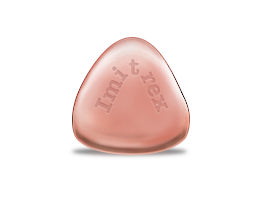
Imitrex, also known by its generic name sumatriptan, is a potent medication prescribed primarily for the treatment of migraines. It is particularly effective in reducing symptoms associated with migraines such as headache pain, nausea, and sensitivity to light and sound. The mechanism of action of Imitrex revolves around its ability to narrow the blood vessels around the brain. This is crucial because during a migraine attack, these blood vessels tend to dilate or expand, which contributes to the characteristic throbbing pain. By narrowing these vessels, Imitrex helps alleviate the pain associated with migraines.


| Package | Per pill | Total price | Save | Order |
|---|---|---|---|---|
| 100mg × 30 Pills | $6.39 | $191.58 + Bonus - 4 Pills | - | Add to cart |
| 100mg × 60 Pills | $6.04 | $362.11 + Bonus - 4 Pills Free Trackable Delivery | $21.00 | Add to cart |
| 100mg × 120 Pills | $5.86 | $703.16 + Bonus - 7 Pills Free Trackable Delivery | $63.60 | Add to cart |
| Package | Per pill | Total price | Save | Order |
|---|---|---|---|---|
| 50mg × 10 Pills | $8.66 | $86.64 + Bonus - 4 Pills | - | Add to cart |
| 50mg × 20 Pills | $6.77 | $135.47 + Bonus - 4 Pills | $37.80 | Add to cart |
| 50mg × 30 Pills | $6.14 | $184.31 + Bonus - 4 Pills | $75.60 | Add to cart |
| 50mg × 60 Pills | $5.51 | $330.81 + Bonus - 4 Pills Free Trackable Delivery | $189.00 | Add to cart |
| 50mg × 90 Pills | $5.30 | $477.31 + Bonus - 7 Pills Free Trackable Delivery | $302.40 | Add to cart |
| 50mg × 120 Pills | $5.20 | $623.81 + Bonus - 7 Pills Free Trackable Delivery | $415.20 | Add to cart |
| Package | Per pill | Total price | Save | Order |
|---|---|---|---|---|
| 25mg × 10 Pills | $6.98 | $69.83 + Bonus - 4 Pills | - | Add to cart |
| 25mg × 20 Pills | $5.46 | $109.18 + Bonus - 4 Pills | $30.40 | Add to cart |
| 25mg × 60 Pills | $4.44 | $266.60 + Bonus - 4 Pills Free Trackable Delivery | $152.40 | Add to cart |
| 25mg × 90 Pills | $4.27 | $384.67 + Bonus - 7 Pills Free Trackable Delivery | $243.90 | Add to cart |
| 25mg × 120 Pills | $4.19 | $502.74 + Bonus - 7 Pills Free Trackable Delivery | $334.80 | Add to cart |
Understanding the Progression of Migraines?
Migraines are a type of headache that can cause intense, throbbing pain or a pulsing sensation, commonly on one side of the head. These headaches are often accompanied by nausea, vomiting, and extreme sensitivity to light and sound. Migraine attacks can last anywhere from several hours to several days, with pain so severe that it can significantly disrupt daily activities.
Some individuals may experience a warning symptom known as an aura prior to or during a migraine attack. An aura can involve visual disturbances, such as seeing flashes of light or experiencing blind spots, or other disturbances, like tingling on one side of the face or in an arm or leg, or difficulty speaking.
There are medications available to help prevent some migraines and reduce their intensity. A combination of the right medications alongside self-help remedies and lifestyle changes might be beneficial in managing migraines. It is essential to consult with a healthcare professional to determine the best course of treatment based on individual needs and medical history.
Migraine, a complex neurological disorder, is characterized by recurrent episodes of intense headaches, often accompanied by a variety of other symptoms. These episodes, known as migraine attacks, are typically divided into four distinct phases: premonitory symptoms, aura, headache, and postdrome. It's important to note that not everyone experiences all four phases, and the symptoms can vary greatly from person to person.
1. Premonitory Symptoms: This phase can occur up to 24 hours before the onset of a migraine attack. People may experience a range of premonitory symptoms, including food cravings, unexplained mood changes like depression or euphoria, uncontrollable yawning, fluid retention, or increased urination. These symptoms can serve as early warning signs, allowing individuals to prepare for or even prevent a full-blown migraine attack.
2. Aura: The aura phase is not experienced by everyone who has migraines. It usually occurs immediately before or during the migraine itself. Visual disturbances are the most common aura symptoms, with people seeing flashing or bright lights, or what looks like heat waves. Some may also experience muscle weakness or the sensation of being touched or grabbed, known as sensory aura. The duration of the aura phase is typically less than an hour.
3. Headache: The headache phase is the most recognized part of a migraine attack. The pain is often described as a throbbing or pulsing sensation on one side of the head. However, it's possible to have a migraine without a headache, a type known as 'silent' or 'acephalgic' migraine. The pain usually builds in intensity and can last from a few hours to several days if untreated.
4. Postdrome: The postdrome, also known as the 'migraine hangover,' occurs after the headache phase. Individuals often feel exhausted or confused following a migraine attack. This phase can last up to a day before people start to feel like their usual selves again. Some people may also experience temporary feelings of happiness or euphoria in this phase.
Understanding these four phases can help individuals better manage their migraines. By recognizing the early signs and taking appropriate action, it may be possible to reduce the frequency and severity of migraine attacks.
The two major types of migraine are migraine with aura and migraine without aura.
1. Migraine with aura, previously known as classic migraine, is characterized by visual disturbances and other neurological symptoms that typically occur 10 to 60 minutes before the onset of the actual headache. These symptoms, collectively referred to as the aura, usually last for no more than an hour. Individuals experiencing a migraine with aura may temporarily lose partial or complete vision. The aura can also manifest as trouble speaking, abnormal sensation or numbness, muscle weakness on one side of the body, or a tingling sensation in the hands or face, along with confusion. Other symptoms that may precede the headache include nausea, loss of appetite, and increased sensitivity to light, sound, or noise. It's worth noting that the aura can occur without the headache pain, which can strike at any time.
2. Migraine without aura, often referred to as common migraine, is the more prevalent form of migraine. Symptoms include headache pain that occurs without warning and is usually felt on one side of the head. Other accompanying symptoms may include nausea, confusion, blurred vision, mood changes, fatigue, and increased sensitivity to light, sound, or noise.
Other types of migraine.
- Abdominal migraine mostly affects young children and involves moderate to severe pain in the middle of the abdomen lasting one to 72 hours, with little or no headache. Additional symptoms include nausea, vomiting, and loss of appetite. Many children who develop abdominal migraine will have migraine headaches later in life.
- Basilar-type migraine mainly affects children and adolescents. It occurs most often in teenage girls and may be associated with their menstrual cycle. Symptoms include partial or total loss of vision or double vision, dizziness and loss of balance, poor muscle coordination, slurred speech, a ringing in the ears, and fainting. The throbbing pain may come on suddenly and is felt on both sides at the back of the head.
- Hemiplegic migraine is a rare and severe form of migraine that causes temporary paralysis—sometimes lasting several days—on one side of the body prior to or during a headache. Symptoms such as vertigo, a pricking or stabbing sensation, and problems seeing, speaking, or swallowing may begin prior to the headache pain and usually stop shortly thereafter. When it runs in families the disorder is called familial hemiplegic migraine (FHM). Though rare, at least three distinct genetic forms of FHM have been identified. These genetic mutations make the brain more sensitive or excitable, most likely by increasing brain levels of a chemical called glutamate.
- Menstrual migraine affects women around the time of their period, although most women with menstrually-related migraine also have migraines at other times of the month. Symptoms may include migraine without aura, pulsing pain on one side of the head, nausea, vomiting, and increased sensitivity to sound and light.
- Migraine without headache is characterized by visual problems or other aura symptoms, nausea, vomiting, and constipation, but without head pain.
- Ophthalmoplegic migraine an uncommon form of migraine with head pain, along with a droopy eyelid, large.






